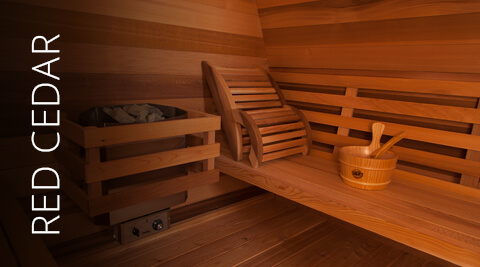Traditional Sauna Things To Know Before You Buy
Traditional Sauna Things To Know Before You Buy
Blog Article
Examine This Report on Traditional Sauna
Table of ContentsHow Traditional Sauna can Save You Time, Stress, and Money.4 Simple Techniques For Traditional SaunaThe Main Principles Of Traditional Sauna Examine This Report on Traditional Sauna
Most of the weight shed in a sauna is water loss and is re-gained upon rehydrating. Without a question sauna can be an important component of a healthy weight loss program. To check out the distinctions in between standard and IR saunas, I will separate these into verifiable, theoretical, and made differences.Therefore, the best point in the saunawhich goes to the ceiling straight above the sauna heateris commonly between 185 and 190 F. Traditional Sauna. Claims that a typical sauna exceeds 200 F is just not true and not suitable for electric saunas offered in the US. The temperature level for a far-infrared sauna is typically set between 120 and 140 F; nevertheless, unlike the typical sauna, the goal in and IR room is not to accomplish a high temperature level
Due to the fact that of this, the temperature difference is nearly unimportant, because extreme sweating results in both sauna kinds, however the technique of warming the body is different. In an IR sauna the bather will certainly feel warm and will sweat a lot, but at a lot lower temperatures. Therefore, if the objective is to invest longer time periods in the sauna, the IR sauna is a good choice.

Traditional Sauna - Truths
When the high temperature is achieved, the aspects cycle on and off to maintain the heat. A lot of standard sauna users take pleasure in putting water over the rocks to create vapor to increase sauna moisture degrees. The advantages of pouring water over the rocks consist of: making the space a lot more comfortable, dampening the nasal flows, and permitting the use of aromatherapy by mixing vital oils with the water.
In a far-infrared sauna, the warm front penetrate the body to efficiently heat up the body and elevate the body core temperature. To attain this enhanced temperature level, Far-infrared emitters produce infrared energy which is close to the exact same wavelength as that which the body naturally emitsoften described as the "Vital Array" of 7 to 14 microns), so the energy is well received by the body.
When the power goes into the body, it causes the body temperature to raise and inevitably causes sweat. In an infrared sauna it's crucial for the emitters/heaters to remain on practically continuously. Because there is no mass of rocks to maintain heat, the sauna will certainly cool down if the emitters shut down.
As pointed out above, the sauna bather in an infrared room desires to place himself in front of operating emitters to get maximum gain from the warmth. The home heating time for the two spaces can be really various, relying on how the spaces are used. For a conventional sauna, a bather needs to permit 30-40 minutes for the space to accomplish a desired temperature and to appropriately pre-heat the rocks.
How Traditional Sauna can Save You Time, Stress, and Money.
A well built sauna will commonly accomplish a temperature of 150-160 F in about 30-40 mins (Traditional Sauna). For hotter temperature levels, the area might need to heat for a longer duration. As soon as the space achieves set temperature level, the heating system will cycle on and off, usually operating concerning 50% of the time. The insulated wall surfaces and the warmed rocks will certainly keep the room hot and at secure temperatures.
To some, 15 mins was "thrown away" while the infrared energy warmed the wood panels as opposed to heating up a body, while others find a pre-heated space to be more comfy and think a raised starting temperature level is essential to begin perspiring. The size of suggested use for every space is roughly the same (10-15 mins per session); however, because of the lower air temperatures and the capability to feel the results of infrared go heat much faster than a standard sauna, it is not uncommon for an individual to spend a total of 20-30 mins in an infrared sauna.
Traditional saunas tend to be bigger (for this reason use even more electricity) than infrared saunas, although traditional saunas are absolutely available in one and two person sizes. For a two-person conventional sauna, 5x6 or 5x7 dimension is most prominent. The leading bench can easily seat 2 or three people and is also enough time to relax during the sauna session.


The typical expense per kWH of electrical power in the united state is about $0.11, so a 4.5 kW heating system will set you back about $.50 to run for one hour, if the heater runs constantly for one hour. Usually a sauna heater will run for 75% of the first hour and 50% of subsequent hours on because the elements cycle once the set temperature level is accomplished.
Unknown Facts About Traditional Sauna
A two go to my blog individual far-infrared space is usually physically smaller sized than a traditional sauna, typically concerning 4' x 4' or smaller sized. The IR furnace is typically 1.5-1.7 kW utilizing a 120 volt 15 amp plug-in service. Considering that the space can be used sooner than a sauna space, we will presume the room is utilized for to of an hour including warmth up time.
Lastly, there is a seldom discussed difference in the social experience between both spaces. While our culture has shed several of the social advantage of the traditional sauna experience, it can be really socially gratifying. From household time in the advice sauna, to heart-felt conversations with better halves, to sauna partiesthe typical sauna experience can bring about intimate mingling.
A lot of higher end infrared areas include colored light therapy, noise systems and full-glass fronts.
Report this page